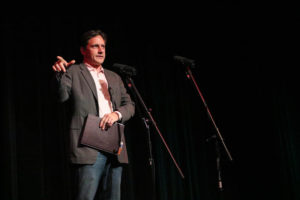The Wall Street Journal is better than most, but still I find myself shaking my fist at the paper from time to time.
Earlier this week, in anticipation of the relaxation of rules for Hedge Fund advertising – and most importantly, the WSJ’s pole position to attract that advertising – they ran an explanatory article on ‘What is a Hedge Fund?’
Ask 10 investors to define “hedge fund” and you’re likely to get 10 different answers.
The catchall term is used to describe an industry with an estimated $2.4 trillion in assets and an array of portfolios that feature dramatically different investment strategies, tolerance for risk and goals for returns.
“It’s a misguided term that tells you nothing” about the manager’s investment approach, says Jason Gerlach, president of the California Hedge Fund Association and managing director at hedge-fund firm Sunrise Capital Partners LLC in San Diego.
Instead, the term generally refers to the structure of the investment: “It generally means a private investment partnership” instead of, say, a mutual fund, Mr. Gerlach says.
Though long viewed by many as secretive instruments offered only to the extremely wealthy via privileged connections or exclusive websites, hedge funds are about to come out of the closet: An 80-year-old ban on hedge-fund advertising is falling away, and some of these private investment pools are gearing up to launch ad campaigns—likely as early as this month.
Mysterious for a Reason?
Some believe the advertisements will help demystify the strategies used by hedge-fund managers. “Hedge funds are often raked over the coals because they’re mysterious, but they’re mysterious because regulators don’t let them talk,” says Mitch Ackles, president of the Hedge Fund Association and chief executive of Hedge Fund PR LLC, a strategy and marketing company.
Hedge-fund manager John Paulson reaped huge gains betting against subprime mortgages in 2007 and 2008.
The term “hedge fund” was reportedly first used by Alfred Winslow Jones, a sociologist and financial journalist who created an investment partnership in 1952. Mr. Jones used leverage—that is, borrowing—to increase his investment exposure, and sold short what he believed to be overvalued securities in an attempt to “hedge” the market and profit regardless of whether it rose or fell.
Today, hedge funds still generally employ a hedging technique—counterbalancing one investment against another—but even that is not always the case, says Josh Charney, a fund analyst at investment-research firm Morningstar Inc. “That was the first purpose of a hedge fund, to hedge and offer some safety, but over time it has strayed from that original definition,” he says.
But hedge funds still typically have more-flexible investment strategies than mutual funds. They may have higher leverage, for instance, or invest heavily in illiquid holdings such as art, antiques or thinly traded securities.
For these more aggressive tactics, the funds typically charge steeper fees than do mutual funds, generally an asset-management fee of 1% to 2% and a performance fee of 20% of the fund’s profit annually.
In an effort to protect investors with limited means, hedge funds are closed by federal securities law to all but “accredited” investors—which includes individuals with an annual income that exceeds $200,000 for the past two years or a net worth exceeding $1 million excluding their primary residence. In addition, the funds generally require minimum investments of at least $250,000 and limit how frequently investors may withdraw cash.
Hedge Fund Research Inc.’s HFRI Fund Weighted Composite Index, a broad proxy for the hedge-fund universe, gained 3.8% this year through August (net of fees), while the S&P 500 index gained 16.2% with dividends and the Barclays Government/Credit Bond Index shed 3.2% over the same period, according to HFR. For the five years through August, the HFRI Fund Weighted Composite Index gained an annualized 3.4% while the S&P 500 index gained 7.3% with dividends.
Range of Volatility
Investors generally look to the funds to reduce volatility. But prospective investors should understand that just as some hedge-fund strategies may enhance returns, they may also amplify losses, and some strategies are more volatile than others.
“Investors have to judge each fund individually because fund managers may be doing vastly different things,” says Mr. Ackles.
“Relative value” arbitrage strategies account for about 27% of industry assets, according to HFR. Managers of relative-value funds will simultaneously buy markets or investments expected to appreciate, while selling related securities expected to depreciate, seeking to profit from their relative value. That allows the funds to generate returns with little correlation to markets. Such strategies can be executed with convertible bonds, preferred securities, options, warrants and other instruments.
As Hurricane Katrina bore down on the U.S. in the summer of 2005, for example, some hedge-fund managers owned short-term contracts on oil and gas, a bet that prices would rise soon. But they also took bearish positions on longer-dated contracts, a bet that the prices would fall in coming months.
Relative-value arbitrage funds may employ lots of leverage, which can result in big gains or losses. Long-Term Capital Portfolio LP, which famously collapsed in 1998, was a relative-value fund.
This year through July, the HFRI Relative Value (Total) Index has gained about 3.6%, according to HFR.
Then there are event-driven hedge funds, which invest in securities that may be affected by corporate activity such as bankruptcies, mergers, reorganizations and hostile takeovers. Managers of these funds seek to predict the relative movement of the securities involved. A manager may invest, for example, in the stock of a company that is being acquired while also selling short the stock of the acquiring company. Event-driven strategies that focus on companies in financial trouble are often referred to as distressed investing.
Event-driven funds fared well in the first half, partly due to a dynamic merger-and-acquisition and corporate-actions environment, according to HFR. The HFRI Event-Driven (Total) Index gained 6.9% this year through July. Funds using these strategies account for about 26% of industry assets, according to HFR.
Next in size, with about 21% of industry assets, HFR says, are so-called macro strategy hedge funds, which, as their name suggests, invest with a broad outlook that tries to anticipate changes in economic trends and policy decisions.
Some of the funds that use a macro strategy invest in stocks, bonds, currencies and commodities, and may shift their exposure to asset classes and countries rapidly. Such funds often employ leverage and derivatives to enhance the impact of market moves, and their returns may be very volatile as a result.
Global macro investing is one of the best-known hedge-fund strategies, partly because it has been employed by well-known managers such as George Soros and Julian Robertson.
Many macro hedge funds were popular in the 1990s and posted big gains during the 2008 financial crisis. This year through July, the HFRI Macro (Total) Index has slipped 0.95%, according to HFR.
Ms. Maxey is a special writer for The Wall Street Journal in New York. Email her at daisy.maxey@wsj.com.
Post read (8302) times.
 Last week I did a Texas Public Radio live storytelling event with the theme “Big Break and Busts,” so naturally I told the story of my failed investment fund. I’ve covered a bit of this before, as the Bankers Anonymous Origin Story.
Last week I did a Texas Public Radio live storytelling event with the theme “Big Break and Busts,” so naturally I told the story of my failed investment fund. I’ve covered a bit of this before, as the Bankers Anonymous Origin Story.


